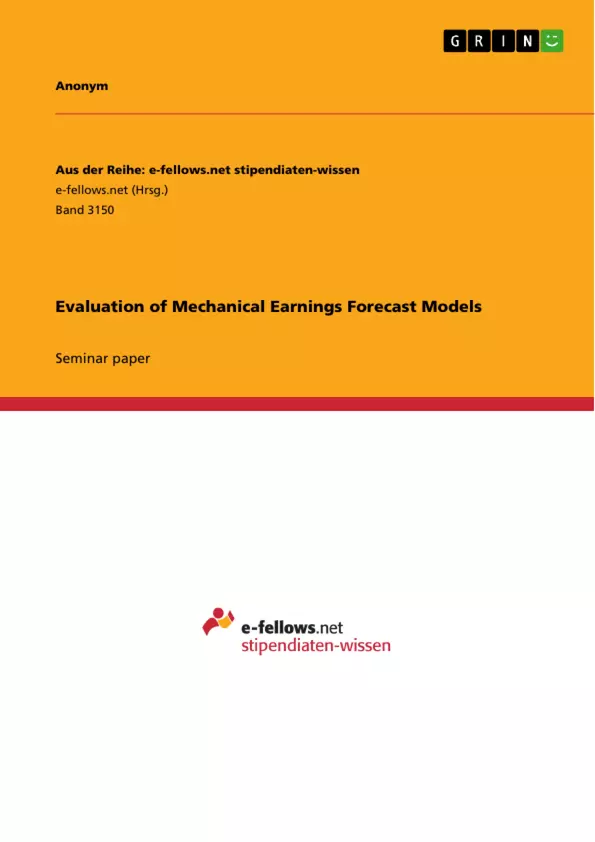This paper seeks to examine different models to forecast revenue of companies. This is being achieved by examining costs of capital, which are a good representative therefor. The models examined in this paper can be divided into two sections. First, there are mechanical models, second there is one characteristic-based model. The models stand in contrast to analysts’ forecasts. This paper sums up different authors who illustrate, that mechanical models outperform analysts’ forecasts in terms of revenue forecasting. First, the HVZ mode is introduced which is due to outperform analysts’ forecasts. Second, the EP and RI model are introduced, next to a random walk model (RW model) as a benchmark. Objective of this paper is to find out which advantages go along with mechanical models, and whether the quality of forecast could be influenced positively.
The topic of revenue forecast is highly relevant for different stakeholders in the financial industry. Based on revenue forecasts investment decisions are met by investors. One advantage of mechanical models therefore, is the greater feasibility due to the greater coverage. Mechanical models rely on firm fundamentals and are hence available for much more companies. Analysts’ forecasts are only available for firms of a certain size upwards. Costs of capital are a topic of focus not only for investment decisions but also for internal application. Apart from the use as a financial ratio it is negatively associated with customer satisfaction.
The paper finds out, that the HVZ model outperforms analysts’ forecasts in terms of forecast bias and earnings response coefficient. However, the HVZ model does not outperform analysts’ forecasts in terms of accuracy. The EP and RI model both outperform the HVZ model in terms of all three criteria: forecast bias, earnings response coefficient and accuracy. The characteristic-based model sets up a linear function solely by firm fundamentals, that avoids including unobservable future covariances. Besides, it concludes certain key findings about abnormal earnings volatility and economy-wide risk.
Inhaltsverzeichnis (Table of Contents)
- 1. Introduction
- 2. Mechanical Revenue Forecast
- 2.1. Preliminaries
- 2.2. HVZ model
- 2.3. RW model
- 2.4. EP model
- 2.5. RI model
- 2.6. Conclusion
- 3. Characteristic-based rate of return forecast
- 3.1. Preliminaries
- 3.2. Three propositions
- 3.2.1. First proposition
- 3.2.2. Second Proposition
- 3.2.3. Third Proposition
- 3.3. Conclusion
- 4. Conclusion and Outlook
Zielsetzung und Themenschwerpunkte (Objectives and Key Themes)
This paper analyzes different models for forecasting company revenue by examining their costs of capital, which serve as a good representative. It compares mechanical models with a characteristic-based model and contrasts them with analysts' forecasts. The study aims to understand the advantages of mechanical models and whether they can improve forecast quality.
- Comparison of mechanical and characteristic-based revenue forecast models
- Evaluation of the effectiveness of mechanical models in predicting revenue
- Analysis of the advantages and limitations of mechanical models compared to analysts' forecasts
- Examination of the role of implied cost of capital (ICC) in revenue forecasting
- Assessment of the impact of different ICC metrics on model performance
Zusammenfassung der Kapitel (Chapter Summaries)
- Chapter 1: Introduction Introduces the paper's objective to compare and analyze different revenue forecasting models. It emphasizes the relevance of revenue forecasts for various stakeholders in the financial industry and highlights the advantages of mechanical models in terms of feasibility and coverage.
- Chapter 2: Mechanical Revenue Forecast This chapter focuses on three mechanical revenue forecast models: the HVZ model, the EP and RI model, and the RW model. It discusses the role of implied cost of capital (ICC) in these models and presents various ICC metrics used for calculation. The chapter also examines the criteria for evaluating model success, including coverage, forecast bias, and accuracy.
- Chapter 3: Characteristic-based Rate of Return Forecast This chapter explores a characteristic-based model that utilizes firm fundamentals to construct a linear function. It emphasizes the avoidance of unobservable future covariances and presents key findings about abnormal earnings volatility and economy-wide risk.
Schlüsselwörter (Keywords)
The primary keywords and focus topics of this text include revenue forecasting, mechanical models, characteristic-based models, implied cost of capital (ICC), forecast bias, forecast accuracy, earnings response coefficient, abnormal earnings volatility, and economy-wide risk.
- Citar trabajo
- Anonym (Autor), 2018, Evaluation of Mechanical Earnings Forecast Models, Múnich, GRIN Verlag, https://www.grin.com/document/491784



